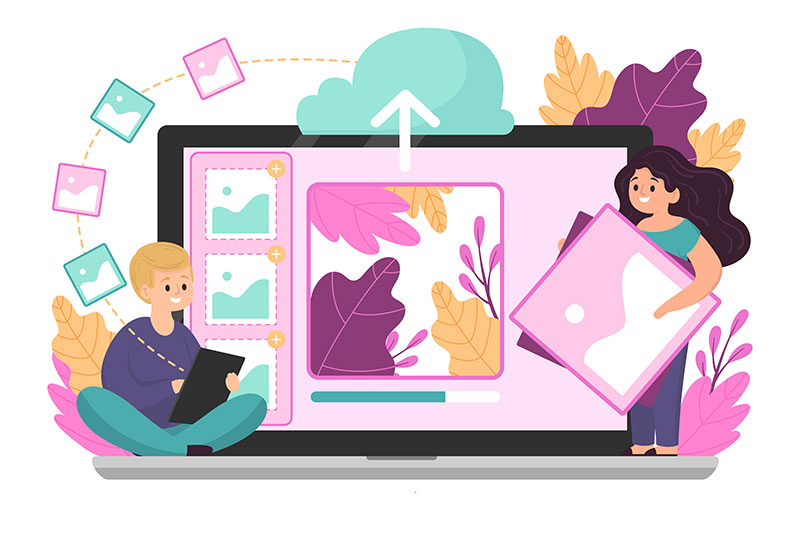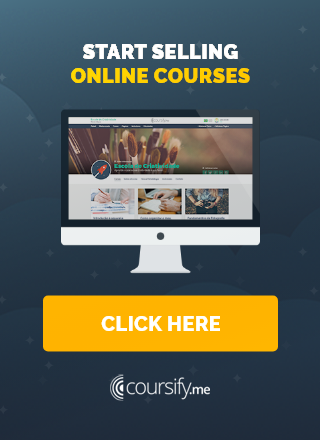12 Tips and Tricks for Including Images in Your Online Course
Including visual content in your online course can offer several benefits to both instructors and learners.
In this article we will cover the best ways to use images to capture learners’ attention and make the course more engaging.

Best ways to include images in your online course
It is very common to use photos and images in general in teaching materials, as they can break up text-heavy content, making it more appealing and interactive.
Also, they can help clarify complex concepts or processes by providing visual representations, making it easier for learners to understand and retain information.
While including images in your online course offers numerous advantages, it’s important to use them strategically. See below 12 tips on how you can do this in the best way.
1. Optimize Your Images for Web Display
According to HTTP Archive, images makeup on average 21% of a total webpage’s weight.
So, to help the speed of your online course it’s important to optimize your images. Here are some quick tips:
- Reduce file size without compromising quality, using tools like Adobe Photoshop or free online services like TinyPNG and Compressor.io.
- Use appropriate image formats, such as JPEG for photographs and PNG for transparent images. Choosing the correct format can significantly reduce file size.
- Implement lazy loading techniques for images, which means images are only loaded when they are visible on the screen. This saves bandwidth and speeds up page loading.
Also, to optimize your online course for SEO, you can include pertinent captions, alt text, and descriptions in the images.
– 12 practical tips of SEO for beginners
2. Choose the Right Photos
The photos you choose play a huge role in conveying your online course content.
Here are some aspects to consider:
- Relevance: The images should align with the course content at that point.
- Quality: Choose high-resolution images for a professional appearance.
- Variety: Mix up styles (graphs, infographics, stills) to avoid visual monotony.
- Emotional connection: Try including pictures producing an emotional response, as they can enhance learning and retention rates.
You can find good free images and photos on sites like Freepik, Pexels and Unsplash.
3. Integrate Charts, Infographics and Diagrams Effectively
Like we pointed before, when explaining complex concepts, visual representations can be your best friends.
This even helps when you are getting to grips with elearning itself. Consider these points while using infographics and diagrams:
- Clarity: Ensure the graphic communicates information clearly without requiring extensive text. Also, be careful not to use too many colors and make the reading confusing.
- Type: The type of chart you choose must match the data you want to represent. For example, use bar charts for comparisons, pie charts to show proportions, and line charts to show trends over time.
- Strategic placement: Position these aids near relevant textual content for aiding comprehension.
It is very important to keep these images updated. If the data evolves over time, update the chart to reflect the most recent information.
4. Change a Photo’s Background
Backgrounds can dramatically change the impact of an image. This is how you do it:
- Choose your photo: Start with a clear, high-quality image.
- Select tools: With the help of a background changer tool, isolate the subject and remove the existing backdrop.
- Take care on edges: Ensure smooth transition between subject and new background to avoid it looking unnatural.
Remember, consistency among images across your course helps provide visual continuity for learners, and getting rid of backgrounds allows you to achieve this in a flash.
5. Build Visual Hierarchy Using Photos
Visual hierarchy not only orchestrates aesthetics but helps learners prioritize information. Implement it using these steps:
- Importance dictates size: The more pertinent an image is, the larger its scale should be.
- Placement: Top-to-down arrangements generally imply precedence.
- Color and contrast: Vibrant colors or contrasting shades can draw attention to specific elements on your page.
Understanding visual flow can significantly enhance user experience, helping learners digest material effectively.
6. Create Balance between Textual and Visual Elements
Balancing your textual content with photos can make for an engaging learning environment. Here’s how:
- Use judiciously: Don’t just include images for the sake of it; they should supplement, not overwhelm your text.
- Align visuals with text: Provide intuitive links between words and images to maximize understanding.
- Quality over quantity: One well-chosen photo can communicate more than several poorly picked ones.
- Focus: Use negative space around photos to create focus. Leave areas clear of elements to highlight what’s important.
In short, striking a balance will bring harmony to course design while avoiding content saturation.
7. Incorporate Dynamic Elements with Still Images
Using dynamic elements alongside your images can offer a multimedia learning experience. Here are some tips for integrating moving visuals in your online course:
- Purposeful integration: Use gifs or short videos that align directly with the material being taught.
- Image Rollovers: Create rollover effects on still images. When you hover over an image, it can change color, show additional information, or reveal hidden elements.
- Zoom In/Out: Provide zoom functionality to allow users to enlarge image details. This is especially useful for high-resolution images.
- Image Carousels: Implement image carousels that allow users to browse a series of images in a designated area of the page.
Dynamic visuals can make key points more memorable and absorbing if used proficiently.
They serve as powerful tools to create an engaging digital learning environment when carefully selected without overdoing it.
– Tips for using videos in online courses
8. Enhance Accessibility for Visually Impaired Learners
In your web design, considering visually impaired learners plays a significant part.
Here’s how you can enhance accessibility:
- Alt-text optimization: Descriptive alt text allows blind or partially sighted individuals to interpret the content of an image.
- Caption utilization: Use captions that describe images concisely. This helps learners understand photos’ relevance without necessarily viewing them.
- High contrast images: Choose photos with clear, high contrast elements. This makes recognizing subjects easier for those who struggle with vision impairments.
Focusing on these points lets us ensure learning inclusivity and improve the overall accessibility of our online course materials.
It’s not just about adding visuals, but also about making sure they are accessible to everyone regardless of ability or disability.
9. Boost Aesthetics through Photo Editing Tools
Photo editing tools can significantly enhance the visual appeal of your online course. Here are a few approaches you could consider:
- Filters and adjustments: Apply consistent filters across photos to unify aesthetics or adjust brightness, contrast, and saturation for better clarity.
- Cropping techniques: Crop images strategically to focus on essential areas or create appealing compositions.
- Adding text overlay: Use this sparingly to emphasize key points without obstructing image details.
These methods can breathe new life into mediocre shots.
Quality is key when selecting photos for an online course, and with careful tweaks using photo editing apps or software, you’ll be able to elevate your visuals while maintaining a professional look throughout the course material.
– Design Tips for Creating Professional Presentations
10. Implement Image Consistency across Course Material
Maintaining consistent images throughout your course can prove beneficial. This could mean:
- Creating style guidelines: Start by establishing a set of style guidelines that outline how images should be used in your course materials. These guidelines can include aspects like image dimensions, color schemes, and image placement.
- Maintaining color schemes: Organize photos around a unified color palette aligned with your brand or the mood of the educational content.
- Using a consistent image treatment: Apply the same image treatment, such as filters, borders, or overlays, to maintain a uniform look. This treatment should align with your course’s visual style.
Image uniformity contributes to an organized visual identity which reinforces learners’ sense of continuity as they navigate through different sections.
The consistency factor also enhances user experience by providing a smooth aesthetic flow from one module to another.
11. Save Resources: Stock Photos vs Custom Graphics
When it comes to populating your online course with visuals, you might wonder about stock photos vs custom graphics. Consider these points:
- Authenticity: While stock images can be impactful, they also run the danger of looking generic, whereas custom illustrations or photo shoots showcase originality.
- Cost: High-quality stock snaps do come at a price, but they could be more affordable when compared to designing graphics or hiring an illustrator.
- Time and effort: Work out if you have the resources for creating unique imagery without encroaching upon other essential tasks. Stock images are ready to use instantly, while custom creations take time to conjure up.
Choosing between both involves balancing needs with available time, money, and expertise. Unique designs can set your content apart but remember not to compromise on image quality in favor of originality alone.
– 7 AI tools that help you create online courses
12. Optimize Course Content for Mobile Viewing
With many people today using portable handsets to access online content, optimizing course content for mobile users is crucial. Here are some tips:
- Responsiveness: Ensure your photos resize to smaller screens without losing clarity or causing awkward alignments.
- File size: Keep image file sizes small. This aids faster load times when accessed on mobile devices with slower internet speed.
- Touch friendly: If you have interactive components, make sure they’re easily usable on touch screens.
Paying attention to these factors during web design and image selection lets you ensure learner accessibility regardless of device used.
An online course should provide a seamless learning experience across all platforms while retaining its aesthetic charm and functionality, so this is something you can’t afford to overlook.
– How to create mobile learning courses
Use great images and make your online course irresistible

Implementing these tips and integrating high-quality images thoughtfully will undoubtedly enhance your online course.
A well-balanced mix of photos, graphics, and text can steer participants’ attention effectively, making the learning journey engaging and memorable.
The main point is that even small adjustments can make a big difference in user experience. So go ahead, experiment with these suggestions to create an exquisite visual narrative for your learners.
And of course take heed of feedback from course participants, as this can pick up on any image issues you don’t spot yourself.
If you create and sell online courses, Coursify.me is the right platform to host and promote your courses.
Complete eLearning platform, mobile friendly, you can upload content through your computer or other platforms, such as YouTube, Dropbox and Vimeo.
– Features of an e-Learning platform
You can also customize the course page with your colors, brand and images, maintaining your visual identity.
To know more, visit our website, test the platform and start creating and selling quality online courses right now.

